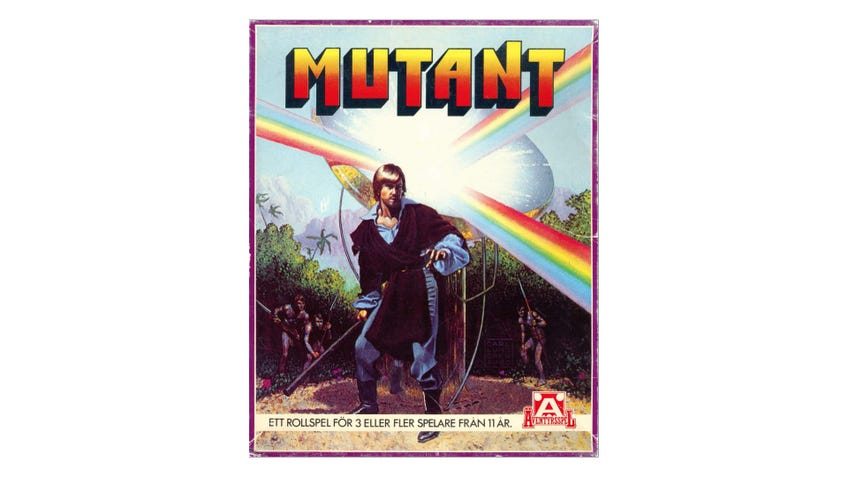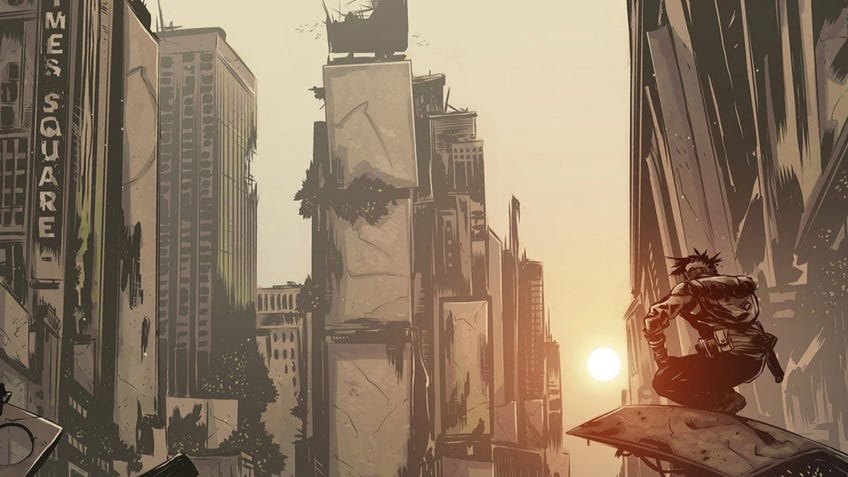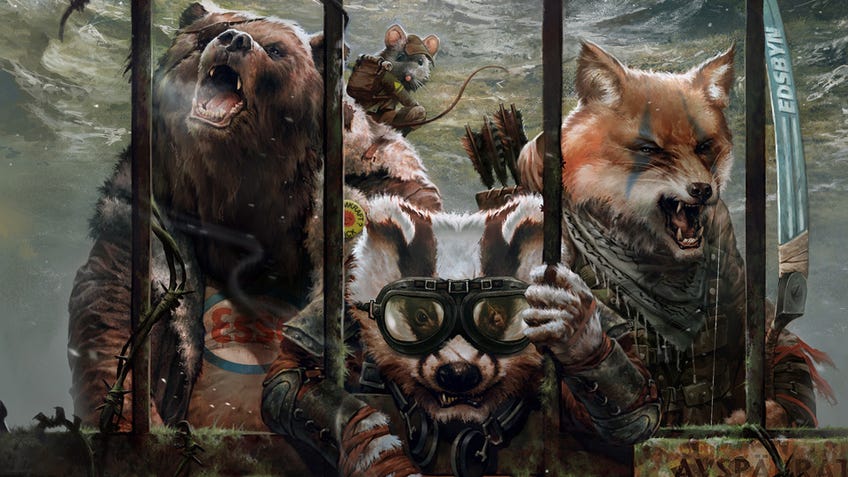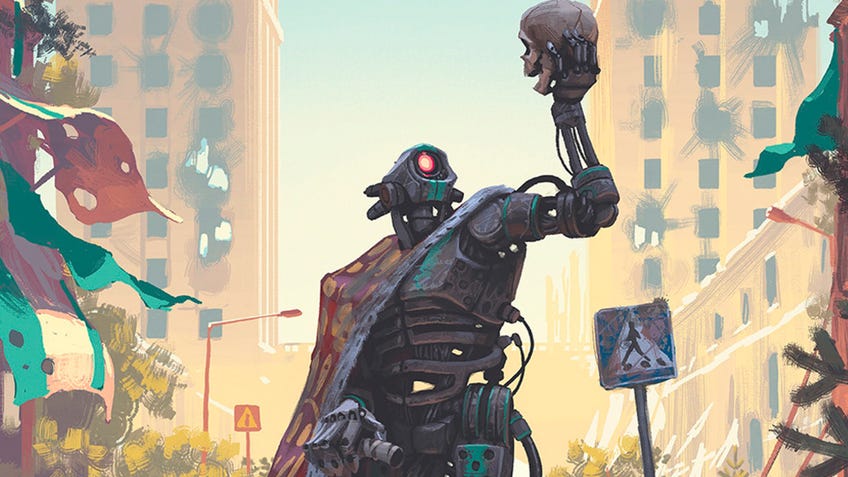Mutant Year Zero: How the end of the world created one of the tabletop’s brightest companies
A Ligan of their own.
It’s been a fantastic few years for tabletop roleplaying games. Kickstarter has allowed fans to connect directly with creators to turn good ideas into great games. Livestreaming has opened up the hobby to a new generation of fans. Dungeons & Dragons is currently in the middle of its most successful edition in years.
One of the largest success stories has been Free League Publishing (aka Fria Ligan) based out of Sweden. It rode the wave of ‘80s nostalgia brought on by Stranger Things to put out the wildly successful Tales from the Loop as a way for gamers to have their own adventures as kids on bikes. It’s followed up with an old-school weird-fantasy hex-map crawl (Forbidden Lands), a sequel to Loop set in the gloomy ‘90s (Things from the Flood) and recently put out an Alien RPG based on the seminal sci-fi horror movie that will finally wash away the terrible memories of the Aliens Adventure Game released by Leading Edge Games in 1991.
All of these RPGs, and more, are powered by the same game engine. The designers have shown a clever knack for keeping the same basic mechanics but bending and adding systems without breaking the mechanic. Players roll a dice pool of six-sided dice assembled from attribute, skill and gear. They need just one 6 to succeed, but that’s hard to do with even two handfuls of dice. The key is pushing; players can pick up and reroll their pools in exchange for trading for a bit of a complicated success. The different games change what that price is, be it the stress dice of Alien or the emotional conditions of Tales from the Loop. It all began with Free League’s first major hit: Mutant Year Zero, published in 2014. But to see the real roots of the game, we must go back further in time… to the future.
The Chronicles of Mutant
Mutant Year Zero is actually a prequel. Mutant, released in 1984 by Swedish company Target Games, offered a bleak future after some unspecified apocalyptic disaster. Players could play humans, robots and mutants trying to make it in this strange new world. Later books in the line would offer new classes and even new settings like a cyberpunk dystopia and mutants in space.

The game also crossed over with two other big names in Swedish design. Elements of Kult were wrapped into the space setting, featuring a hidden planet and a terrible supernatural force unleashed upon the solar system.
Then the game took a page out of Games Workshop’s Warhammer 40,000 book and hurled everything into an even darker future called Mutant Chronicles where massive corporate factions battled for control of the galaxy. The 2003 setting spawned pen-and-paper RPGs, tabletop miniatures games and even a 2009 film featuring John Malkovich, Thomas Jane and Ron Perlman.
Mutant Year Zero brought things back to before all of that. It started simply with a game that focused solely on mutants but has expanded every year to include another one of the character types from the original. The slow worldbuilding through each of these compatible games echoes the original build of the World of Darkness where full games exist in the same universe.
Players could play humans, robots and mutants trying to make it in this strange new world.
Every year has brought a new character type that can either be played in its own game or with characters from other books in the series. Each game is compatible with every game in the series but also has different themes and mechanics that make it unique to the setting.
Though the original was set in Scandinavia, game masters were encouraged to adapt the wasteland their mutants are exploring. Each game in the series includes a sort of metagame that was both influenced by the actions of the players and generated plot based on their actions.
Mutant Year Zero (2014)
The first game focused on mutants. The mutants had been kept inside an Ark for many years; only after the Ark started to break down was the painful decision made to send mutants out into the Zone to scavenge for supplies and make contact with other survivors in the area.
There were several different classes of mutant, each with questions to answer that are a nod to the Powered by the Apocalypse-style of roleplaying games. Many of these questions created rivals and allies within the Ark. This added an element of intrigue to a game built as a map crawl, as there could be some NPCs who didn’t want those explorers to come back.

In this game, players had to trade in the items they found in the wilderness to improve the various scores of the Ark and improve life for the mutants back home. It’s very easy to see the influence of the Fallout video games on Mutant Year Zero. There is a lot of fun to be had battling monsters in the wasteland but those battles influence what happens on the homefront. The decisions on how to improve the Ark drive the narratives of the campaign, which pushes players back out into the Zone and sets up a great feedback loop of external adventures and internal intrigues.
Mutant: Genlab Alpha (2017)
In the original game, mutated, sentient animals were a subclass of mutant. They got their own game in 2017 and it was full of radical departures from Mutant Year Zero. New classes and new abilities based on species were introduced. The mutant point mechanic was adopted into feral points; use a character’s animal abilities too much and there was a chance they would revert to their original animal form. The game also set up the animal mutants inside a laboratory/prison called Genlab Alpha where they were watched over by robots serving long-forgotten masters.
It’s very easy to see the influence of the Fallout video games on Mutant Year Zero.
Instead of exploring and building up an ark, the metagame here is building a resistance movement against robotic oppressors. Players were thrust into leadership of the mutant animals trying to break out of Genlab Alpha and were forced to play a deadly game of cat and mouse with the game master before every session.

The players had to establish alliances with the different gangs of animals, strike where the robots are the weakest and build popular support for the revolution. The robots could come down hard on any uprising, so the players had to be careful about losing beloved NPCs. The metagame played out well in-between sessions too, as the players had to make their own contributions to the fight, which were played out when everyone met to game.
Mutant: Mechatron (2018)
The robots of Genlab Alpha were something of a preview for the next game in the Mutant Year Zero series. Mechatron focused on a still-functioning manufacturing plant in the Zone cranking out supplies for a world that no longer really needs them. The game kept the same structure as the previous two but took advantage of robot modularity.
Characters could swap out parts of their chassis and modify their stats, skills and abilities. Each Mutant Year Zero game offered a deck that could be used to determine the powers and abilities of characters, but Elysium was the first one where that deck could come in very handy as players rebuilt themselves through the campaign.

The campaign game was set up as a reverse of the one in Mutant Year Zero. Instead of collecting supplies to build up their home, the robots needed to scrap and salvage items to keep their home from falling apart. In addition, there’s a twist that mixes in elements of Blade Runner and, of all things, the classic Paranoia RPG. The player characters have become self-aware, but they’ve been put on a task force of robots sent by the central AI to exterminate robots that have gained sentience. This game hewed closest to the cyberpunk roots of the 1989 release with exploration tempered by rain-slicked streets and robots unsure of their lot in life.
Elysium (2019)
Intrigue became the main focus of the most recent release. Elysium focuses on an ultrarich enclave that knew the end was coming and had time to build a giant underground colony to protect their families. These families, in time, became powerful noble houses that run the enclave. The players are members of these houses and also members of the judicators who investigate crimes within the colony. Players who’ve watched Dredd a bunch of times will savour the abilities the judicators have to play judge, jury and executioner.

The tension between what the players do and what the players are come from the adventure hook process in this game. The houses are committing crimes all the time and at the start of each session, the players choose one of a few crimes presented by the Game Master to investigate. Whichever house responsible wants to get away with it and wants their judicator to make sure they do. Every session has tense elements of a traitor deduction game as well as the personal struggle of serving the law or serving the house. The cyberpunk theme is strong here too, but the noir elements will also appeal to players who want to do monologues about their tense lives.
The Road To Eden and Beyond
The Mutant Year Zero brand expanded in a big way with video game The Road to Eden. This XCOM-style tactical RPG video game lets players explore the strange world of the setting through the eyes of a variety of mutants. It also brought things back around to the original setting, with adventures like The Grey Death which involve members of the four expansion books and previews of upcoming setting books where everyone lives together in a massive city and, of course, space.
Each game of the series is a strong individual entry but the series offers a great tapestry of stories to tell. Fans of sci-fi should take a chance to visit Year Zero for some great roleplaying opportunities. The series put Free League on the map thanks to the solid construction of the basic system and the adaptation of story game elements into a more traditional system. Each successive game designed by the company has added elements that have given them unique flavors on their own while still being immediately accessible to fans of Mutant Year Zero. It may be the end of the world in the Zone, but for Free League Publishing, it’s a strong beginning.

